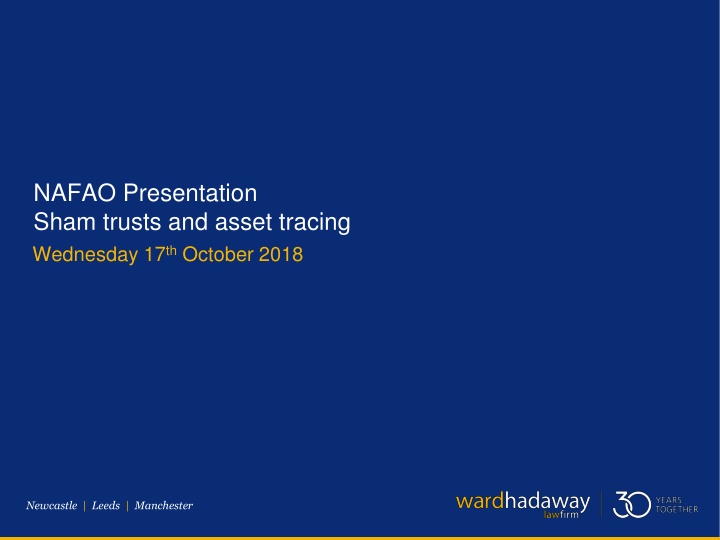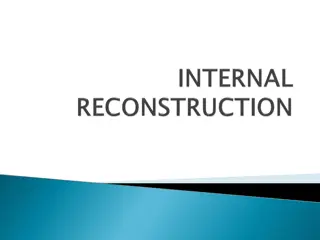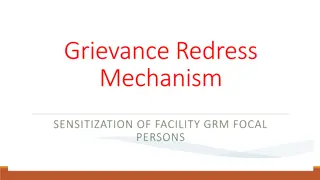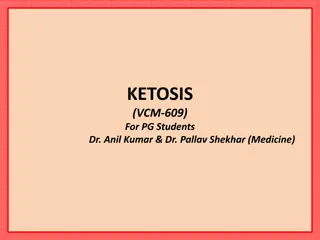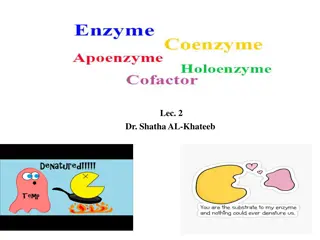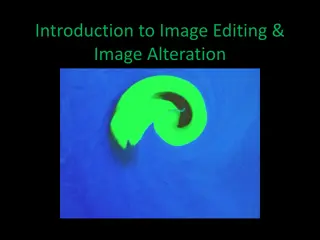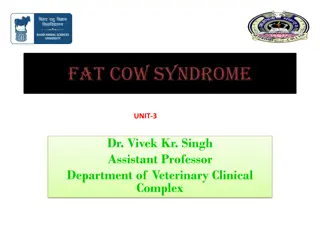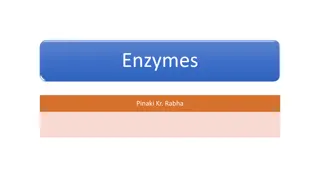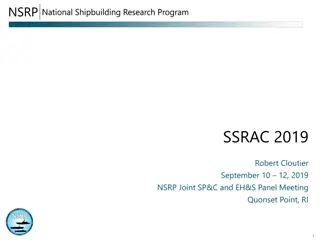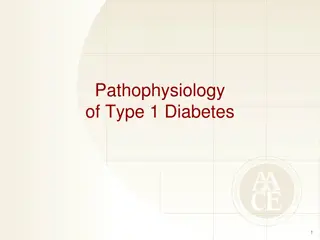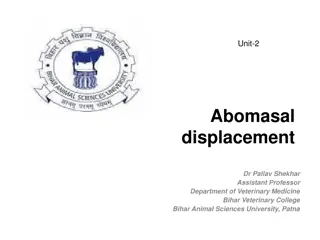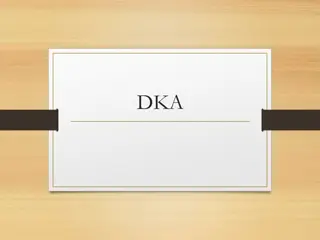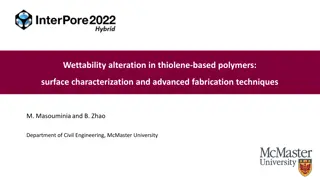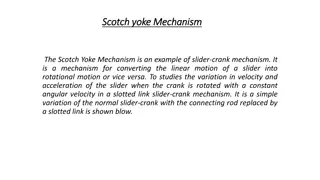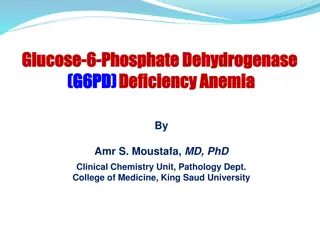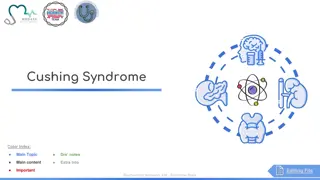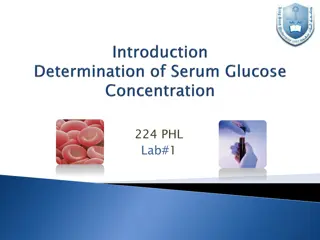Ketosis: Mechanism, Development, and Biochemical Alteration
Ketosis occurs when ketones are present in body fluids in elevated concentrations, often in response to low glucose availability. This process involves the liver shifting from carbohydrate metabolism to fatty acid metabolism, producing ketone bodies as an alternative energy source. Various types of ketosis exist, including alimentary, fasting, diabetic, and pregnancy/lactation-related ketosis. Biochemical alterations such as ketonemia, hypoglycemia, and ketonuria can indicate the presence of ketosis. Explore the mechanisms and implications of ketosis in different contexts.
Download Presentation

Please find below an Image/Link to download the presentation.
The content on the website is provided AS IS for your information and personal use only. It may not be sold, licensed, or shared on other websites without obtaining consent from the author.If you encounter any issues during the download, it is possible that the publisher has removed the file from their server.
You are allowed to download the files provided on this website for personal or commercial use, subject to the condition that they are used lawfully. All files are the property of their respective owners.
The content on the website is provided AS IS for your information and personal use only. It may not be sold, licensed, or shared on other websites without obtaining consent from the author.
E N D
Presentation Transcript
NAFAO Presentation Sham trusts and asset tracing Wednesday 17thOctober 2018 Newcastle | Leeds | Manchester
Speaker profiles Martin Woodford Partner | Commercial Litigation E: martin.woodford@wardhadaway.com T: 0191 204 4428 Joe Kelley Associate | Commercial Litigation E: joe.kelley@wardhadaway.com T: 0191 204 4295 Newcastle | Leeds | Manchester
Topics to be covered 3 (a) Introduction to sham trusts: (i) Starting position; (ii) Ingredients of a sham trust; (iii) Typical indicators of a sham trust. (b) Challenging sham trusts a practical example Newcastle | Leeds | Manchester
(a)(i) Starting position 4 A sham is a transaction which in legal reality is one thing but is dressed up to pretend to be something else. The essence is pretence and deceit. W T Ramsay Ltd v Inland Revenue Commissioners [1982] Whilst professing to be one thing, it is in fact something else. Newcastle | Leeds | Manchester
(a)(i) Starting position 5 A trust is a sham where it is intended that there should be no genuine passing of control of trust property from the person who establishes the trust (settlor) to the person who manages the trust (trustee). The settlor wants the benefits of a valid trust, but he does not want to give up the benefits of absolute ownership. Therefore he disguises his retained ownership in the form of a trust. The court treats sham trusts as void. Newcastle | Leeds | Manchester
(a)(i) Starting position 6 Midland Bank v Wyatt [1995]: Mr Wyatt settled his family home on trust for the benefit of his wife and daughter, so as to protect it from any business failure he might suffer. When his business did fail, he sought to protect his house from creditors by relying on the settlement earlier executed, of which his wife was a trustee. It emerged that Mr Wyatt s wife had had no knowledge of the effect or nature of the declaration she signed as trustee . There was a sham, and the declaration of trust was void and could not be enforced. Newcastle | Leeds | Manchester
(a)(ii) Ingredients of a sham trust 7 (1) Intention to mislead third parties ND v SD and others [2017]: The husband established an offshore trust for the benefit of their daughters which the wife was not aware of until she applied for financial remedy orders amongst divorce proceedings. Held - Even an artificial transaction which was put in place for the purpose of asset protection would not necessarily be cast aside as a sham if all the parties to the transaction genuinely intended the agreements incorporated into the document in which they appeared to take effect. Newcastle | Leeds | Manchester
(a)(ii) Ingredient of a sham trust 8 (2) Common intention Where the trust is declared individually, it is the intention of the person establishing the trust (settlor) alone that determines whether there is a sham trust. Where the declaration of trust is bilateral, both the settlor and the trustee must have had a common intention to mislead third parties by giving a false impression that legal rights and obligations were created in accordance with the trusts. Newcastle | Leeds | Manchester
(a)(ii) Ingredient of a sham trust 9 (3) Recklessness as to the true intention Gruppo Torras SA v Al Sabah and Others [2004]: Someone who goes along with the sham neither knowing or caring what he is signing. Newcastle | Leeds | Manchester
(a)(iii) Indicators of a sham trust 10 Trust property not identified trust documents do not contain any description of the property. Settlor secretly in control all decisions about the trust investment and management is taken by the settlor rather than the trustee (whose role is to manage the trust). Trustee does not exercise independent judgement must be more than showing a trustee complies with a request from a settlor to exercise his discretion. Appearance and reality does not correspond the appearance of the trust is designed to deceive. Newcastle | Leeds | Manchester
(b) ABC Limited v (1) The Estate of Mrs Bloggs, (2) Mr Smith 11 Case summary factual background (1) ABC Limited is a company operating in the residential and nursing care home business for the elderly and infirm. Mrs Bloggs (first defendant, now deceased) was a resident and in receipt of nursing care between 01.10.12 08.09.13. Mr Smith (second defendant, Mrs Bloggs son) alleged that the NHS and the City Council should have funded the care fees over this period of time. Newcastle | Leeds | Manchester
(b) ABC Limited v (1) The Estate of Mrs Bloggs, (2) Mr Smith 12 Case summary factual background (2) Prior to Mrs Bloggs being admitted into full time care, she transferred her property into a trust, of which Mr Smith was a beneficiary. In September 2012, Mrs Bloggs healthcare needs were assessed and she was assessed as a self-funder. The funding for Mrs Bloggs care was therefore withdrawn. Newcastle | Leeds | Manchester
(b) ABC Limited v (1) The Estate of Mrs Bloggs, (2) Mr Smith 13 Case summary factual background (3) Mrs Smith dies intestate. The invoices for the care services remained unpaid. The property was subsequently sold from the trust and Mr Smith retained the proceeds. Mr Smith is thought to have been responsible for the transfer of the property into the sham trust, and its subsequent sale. The Claimant wished to pursue a claim against Mr Smith and the Estate of Mrs Bloggs to recover the fees owed. The existence of the trust was viewed as a potentially complicating factor. The Claimant s unpaid invoices and interest totalled over 35,000. Newcastle | Leeds | Manchester
(b) ABC Limited v (1) The Estate of Mrs Bloggs, (2) Mr Smith 14 The Claimant s case see documents 1 and 2 The transfer of the property into trust was a transaction at an undervalue for the purposes of section 423(1) of the Insolvency Act 1986; The purpose of the transfer was to put Mrs Bloggs assets beyond the reach of a person who may at some time make a claim against them (such person being the Claimant or some other provider of residential or nursing care to Mrs Bloggs); The Claimant was a victim of the transfer for the purposes of section 424(1) of the Insolvency Act 1986; The trust into which the property was transferred was a sham. It was always intended that the property would remain the Claimant s, as would the proceeds from any subsequent sale if she were to move into care. Newcastle | Leeds | Manchester
(b) ABC Limited v (1) The Estate of Mrs Bloggs, (2) Mr Smith 15 The Claimant s case continued In order to succeed with the claim against Mr Smith under s423, the Court must be convinced that: The substantial purpose of the property transfer was to put Mrs Bloggs assets beyond the reach of creditors (i.e. ABC Limited); It was Mrs Bloggs intention to put her assets beyond its reach; This had to be the purpose of the transaction and not solely the consequence; and The trust into which the property was transferred was a sham. True legal and beneficial ownership of the property was always meant to remain with Mrs Bloggs. Newcastle | Leeds | Manchester
(b) ABC Limited v (1) The Estate of Mrs Bloggs, (2) Mr Smith 16 The Defendant s case see document 3 Mr Smith was not the personal representative of Mrs Bloggs Estate, and there has been no grant of probate of letters of administration of her estate. The court has not appointed any person to represent to estate pursuant to CPR 19.8(2)(b). Therefore valid service has not been effected. The Defendant contended that the claim should therefore be struck out. Newcastle | Leeds | Manchester
(b) ABC Limited v (1) The Estate of Mrs Bloggs, (2) Mr Smith 17 The Defendant s case - continued The property transfer was only motivated by Mrs Bloggs wishes: To recognise the substantial financial and emotional contribution made by Mr Smith to the property; To formalise what they had for many years considered to be a situation whereby Mrs Bloggs (and her late husband) held the property on trust for their son in any event; and To simplify the administration of the late Mr Bloggs Estate and his personal affairs. Newcastle | Leeds | Manchester
(b) ABC Limited v (1) The Estate of Mrs Bloggs, (2) Mr Smith 18 The Claimant s case in response see documents 4 and 5 In its Request for Further Information (RFI) the Claimant asked: For specific evidence and particulars of the money paid towards the refurbishment of the property and its mortgage by Mr Smith; The manner in which it was alleged that the property was already held on trust for Mr Smith; and How the transfer of the property into trust would have simplified the administration of Mr Bloggs estate in any event. Simultaneously, the Claimant also served a Reply to the Defence which: Detailed the circumstances immediately before the transfer of the property into trust; Referred to contemporaneous documents completed by Mrs Bloggs which evidenced her ownership of the property; and Highlighted an earlier, inconsistent story from Mr Smith as to how he had obtained ownership of the property personally. Newcastle | Leeds | Manchester
Witness statements 19 The Claimant s evidence see document 6 Principal evidence in the form of a witness statement from ABC Limited s financial director, together with supporting documentation. Explained in detail the circumstances by which Mrs Bloggs became a self- funder, and the precise amount which her Estate was therefore liable for. Detailed the challenges raised by Mr Smith in relation to his liability to pay the invoices. Explored the inconsistencies in Mr Smith s story and lent support to the allegation that the transfer of the property was aimed at placing assets beyond the reach of creditors, and that the trust was a sham. Newcastle | Leeds | Manchester
(b) ABC Limited v (1) The Estate of Mrs Bloggs, (2) Mr Smith 20 Settlement see document 7 The Defendant offered settlement arrangements on the basis that the Claimant drop the Claim against Mr Smith and pay his costs (approximately 5,500 plus VAT). This settlement offer was not attractive to the Claimant as they expected their claim against Mr Smith to succeed. The Claimant offered to accept 20,000, plus payment of its legal costs, in full and final settlement of its claim. The Defendant accepted this offer which was reflected in the consent order. Newcastle | Leeds | Manchester
Thank you for listening 21 Newcastle | Leeds | Manchester
